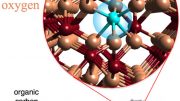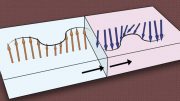
The world’s first technology for consecutively manufacturing epsilon iron oxide that can absorb millimeter waves with a high coercive force equivalent to that of neodymium magnets has been developed by a research team.
KIMS developed the world’s first continuous manufacturing technology for millimeter wave-absorbing magnetic materials.
A research team led by Dr. Youn-kyoung Baek and Dr. Jung-goo Lee succeeded in developing the world’s first technology to consecutively manufacture epsilon iron oxide that can absorb millimeter wave with a high coercive force equivalent to that of neodymium (Nd) magnets. The researchers are in the Department of Magnetic Materials in Powder Materials Division at the Korea Institute of Materials Science (KIMS), a government-funded research institute under the Ministry of Science and ICT.
Iron oxide material with a high-coercive epsilon crystal phase is almost the only magnetic material that absorbs ultra-high frequencies which is a potential 6G frequency band. Until now, it was only formed in a nano-sized particle of 50 nanometers or less. Japan succeeded to produce pure epsilon iron oxide through batch-type wet process, but it involves time-consuming multi-stage process, resulting in a low yield.

Consecutive manufacturing process of epsilon iron oxide. Credit: Korea Institute of Materials Science (KIMS)
The research team adopted the aerosol process to solve the low-yield problem and succeeded in producing a composite powder in which epsilon iron oxide nanoparticles are embedded in silica particles by spray-drying precursor solutions in a hot chamber. When the precursor material solution is continuously injected and the droplets are instantly dried, the iron precursor is trapped in the silica xerogel particles and limited to grow during heat treatment. Epsilon iron oxide nanoparticles could be continuously produced through a micrometer-sized powder manufacturing process, which is significant as it showed the possibility of commercialization of millimeter wave absorbing materials.
While conventional metals that absorb electromagnetic waves have reduced absorption capacity in high-frequency bands or have limitations in controlling frequency bands, epsilon iron oxide has high potential as a material for future communication parts due to its absorption capacity in the ultra-high frequency (30-200GHz) band. Continuous manufacturing technology of epsilon iron oxide with millimeter wave absorption capability can be used for mm-wave 5G/6G wireless communication, radar sensors for driverless car, stealth and low-orbit satellite communication components. In addition, as it is a high-coercivity magnetic material, it can be used for electric motor parts for future mobility.

The shape, magnetic properties and electromagnetic wave absorption properties of the epsilon iron oxide. Credit: Korea Institute of Materials Science (KIMS)
Currently, no companies commercially produce products with applied magnetic materials capable of absorbing mm waves. Only two or three companies in the US, Japan, and Germany produce 5G band absorbing and shielding materials. The technology developed by researchers at KIMS is expected to be localized and exported to the global market in the future.
Principal investigator Dr. Youn-kyoung Baek said, “The epsilon iron oxide can selectively absorb ultra-high frequencies in a wide band (30 to 200 GHz). The significance of the study is that it developed the first continuous manufacturing process of epsilon iron oxides. The technology is expected to accelerate the commercialization of wireless communication devices using millimeter waves, self-driving car radars, and absorber technology for space satellite communication in the future.”
The research was carried out as a project to develop magnetic composite Materials with tunable magnetic performances of KIMS and funded by the Ministry of Science and ICT. In addition, the research was published in Chemical Communications, a renowned academic journal in materials science published by the Royal Society of Chemistry in the UK on September 23rd. Currently, the research team is discussing technology transfer for mass production of iron oxide absorbing materials with many companies, and is conducting a follow-up study to improve wave absorption capacity to terahertz which is 100 gigahertz (GHz) or higher.
Reference: “Facile synthesis of epsilon iron oxides via spray drying for millimeter-wave absorption” by Gi Ryeon Jo, Min Byeol Yun, Yeong Hun Son, Byeongjin Park, Jung-Goo Lee, Young-Guk Kim, Young-Guk Son and Youn-Kyoung Baek, 23 September 2022, Chemical Communications.
DOI: 10.1039/D2CC03168J
Funding: Ministry of Science and ICT
About Korea Institute of Materials Science (KIMS)
KIMS is a non-profit government-funded research institute under the Ministry of Science and ICT of the Republic of Korea. As the only institute specializing in comprehensive materials technologies in Korea, KIMS has contributed to Korean industry by carrying out a wide range of activities related to materials science including R&D, inspection, testing&evaluation, and technology support.









Be the first to comment on "Millimeter Wave-Absorbing Magnetic Materials: Tech To Absorb Electromagnetic Waves in the 6G Band"